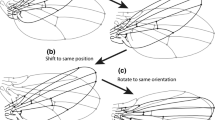Abstract
The problem of modelling variabilities of ensembles of objects leads to the study of the ‘shape’ of point sets and of transformations between point sets. Linear models are only able to amply describe variabilities between shapes that are sufficiently close and require the computation of a mean configuration. Olsen and Nielsen (2000) introduced a Lie group model based on linear vector fields and showed that this model could describe a wider range of variabilities than linear models. The purpose of this paper is to investigate the mathematics of this Lie group model further and determine its expressibility. This is a necessary foundation for any future work on inference techniques in this model.
Let Σk m denote Kendall's shape space of sets of k points in m-dimensional Euclidean space (k > m): this consists of point sets up to equivalence under rotation, scaling and translation. Not all linear transformations on point sets give well-defined transformations of shapes. However, we show that a subgroup of transformations determined by invertible real matrices of size k − 1 does act on Σk m. For m > 2, this group is maximal, whereas for m = 2, the maximal group consists of the invertible complex matrices. It is proved that these groups are able to transform any generic shape to any other. Moreover, we establish that for k > m + 1 this may be done via one-parameter subgroups. Each one-parameter subgroup is given by exponentiation of an arbitrary (k − 1) × (k − 1) matrix. Shape variabilities may thus be modelled by elements of a (k − 1)2-dimensional vector space.
Similar content being viewed by others
References
A. Blake and M. Isard, Active Contours, Springer: London, 1998.
F.L. Bookstein, Morphometric Tools for Landmark Data, Geometry and Biology. Cambridge University Press: Cambridge, 1997.
W.M. Boothby, An Introduction to Differentiable Manifolds and Riemannian Geometry, 2nd edition, Academic Press Inc.: Orlando, Florida, 1986.
T. Bröcker and T. Tom Dieck, Representations of Compact Lie Groups, Vol. 98 of Graduate Texts in Mathematics, Springer-Verlag: New York, 1985.
T.F. Cootes, C.J. Taylor, D.H. Cooper, and J. Graham, “Active shape models—Their training and application,” Computer Vision and Image Understanding, Vol. 61, No. 1, pp. 38–59, 1995.
I.L. Dryden and K.V. Mardia, Statistical Shape Analysis, John Wiley & Sons Ltd: Chichester, 1998.
D.G. Kendall, D. Barden, T.K. Carne, and H. Le, Shape and Shape Theory, Wiley Series in Probability and Statistics, Wiley, 1999.
S. Kobayashi and K. Nomizu, Foundations of Differential Geometry, Vol. II, Tracts in Mathematics, Number 15, Wiley: New York, 1969.
N.H. Olsen and M. Nielsen, “Lie group modelling of nonlinear point set shape variability,” in Algebraic Frames for the Perception-Action Cycle: Second International Workshop, AFPAC 2000, Kiel, Germany, September 10–11, 2000 Proceedings, Vol. 1888 of Lecture Notes in Computer Science, G. Sommer and Y.Y Zeevi (Eds.), 2000, pp. 259–268.
K. Rohr. Landmark-Based Image Analysis, Using Geometric and Intensity Models, Vol. 21 of Computational Imaging and Vision, Kluwer Academic Publishers: Dordrecht, Netherlands, 2001.
C.G. Small, The Statistical Theory of Shape, Springer-Verlag: New York, 1996.
A.F. Swann, K.G. Kvist, and N.H. Olsen, “Transformations of shape space,” in Proceedings fra den 11. Danske Konference i Mønstergenkendelse og Billedanalyse, 22.–23. August 2002, Vol. 15 of Technical Report, Søren I. Olsen (Ed.), Datalogisk Institut, Københavns Universitet, 2002, pp. 3–10.
Author information
Authors and Affiliations
Rights and permissions
About this article
Cite this article
Swann, A., Olsen, N.H. Linear Transformation Groups and Shape Space. Journal of Mathematical Imaging and Vision 19, 49–62 (2003). https://doi.org/10.1023/A:1024437004092
Issue Date:
DOI: https://doi.org/10.1023/A:1024437004092




